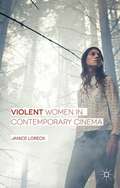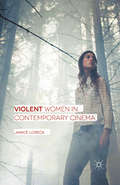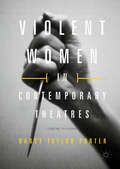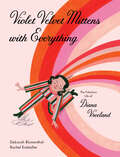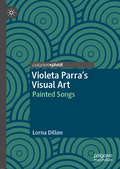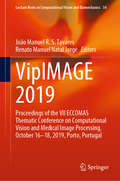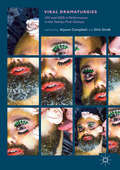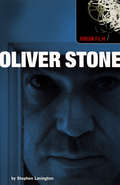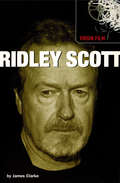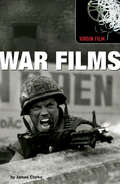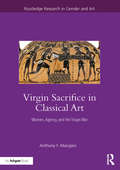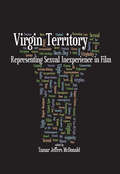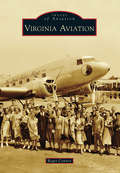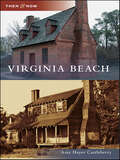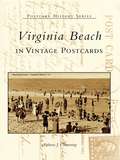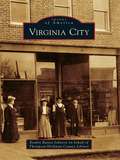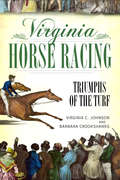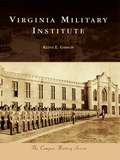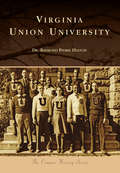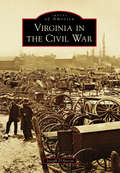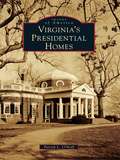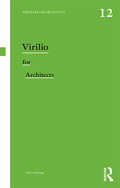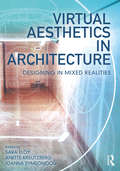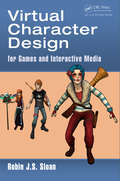- Table View
- List View
Violent Women in Contemporary Cinema
by Janice LoreckViolent women in cinema pose an exciting challenge to spectators, overturning ideas of 'typical' feminine subjectivity. This book explores the representation of homicidal women in contemporary art and independent cinema. Examining narrative, style and spectatorship, Loreck investigates the power of art cinema to depict transgressive femininity.
Violent Women in Contemporary Cinema
by Janice LoreckViolent women in cinema pose an exciting challenge to spectators, overturning ideas of 'typical' feminine subjectivity. This book explores the representation of homicidal women in contemporary art and independent cinema. Examining narrative, style and spectatorship, Loreck investigates the power of art cinema to depict transgressive femininity.
Violent Women in Contemporary Theatres
by Nancy Taylor PorterThis book brings together the fields of theatre, gender studies, and psychology/sociology in order to explore the relationships between what happens when women engage in violence, how the events and their reception intercept with cultural understandings of gender, how plays thoughtfully depict this topic, and how their productions impact audiences. Truthful portrayals force consideration of both the startling reality of women's violence -- not how it's been sensationalized or demonized or sexualized, but how it is -- and what parameters, what possibilities, should exist for its enactment in life and live theatre. These women appear in a wide array of contexts: they are mothers, daughters, lovers, streetfighters, boxers, soldiers, and dominatrixes. Who they are and why they choose to use violence varies dramatically. They stage resistance and challenge normative expectations for women. This fascinating and balanced study will appeal to anyone interested in gender/feminism issues and theatre.
Violet Velvet Mittens on Everything: The Fabulous Life of Diana Vreeland
by Deborah BlumenthalThis wonderful true story of iconic fashion editor Diana Vreeland teaches young readers that individuality is to be celebrated, and that even extraordinary dreams can come true.Violet Velvet Mittens with Everything captures the dramatic, spectacular world of famed fashion icon Diana Vreeland, whose legacy at Harper's Bazaar, Vogue, and the Costume Institute of the Metropolitan Museum of Art continues to influence the fashion world today. As a little girl in Paris, Vreeland loved to read and dance, and most of all dress up. Her love of originality persisted into her career in fashion, where her work was colorful, zany, and never, ever boring. Violet Velvet Mittens with Everything captures Vreeland's larger-than-life personality with an infectiously extravagant tone and style, while showing young readers that above dazzling and daring, being yourself makes the most lasting impact of all.
Violeta Parra’s Visual Art: Painted Songs
by Lorna DillonThis book explores Violeta Parra’s visual art, focusing on her embroideries (arpilleras), paintings, papier-mâché collages and sculptures. Parra is one of Chile’s great artists and musicians, yet her visual art is relatively unknown. Her fusion of complex imagery from Chilean folk music and culture with archetypes in Western art results in a hybrid body of work. Parra’s hybridism is the story of this book, in which Dillon explores Parra’s ‘painted songs’, the ekphrastic nature of her creations and the way ideas translate from her music and poetry into her visual art. The book identifies three intellectual currents in Parra’s art: its relationship to motifs from Chilean popular and oral culture; its relationship to the work of other modern artists; and its relationship to the themes of her protest music. It argues that Parra’s commentaries on inequality and injustice have as much resonance today as they did fifty years ago. Dillon also explores the convergence between Parra’s art and the work of other modern twentieth-century artists, considering its links to Surrealism, Pop Art and the Mexican Muralism Movement. Parra exhibited in open-air art fairs, museums and cultural centres as well as in prestigious venues such as Museu de Arte Moderna do Brasil (the Museum of Modern Art in Brazil) and the Musée des Arts Décoratifs (Museum of Decorative Arts) in Paris. This book reflects on Parra’s socially-engaged work as it was expressed through her exhibitions in these centres as well as in through own cultural centre La carpa de la reina.
VipIMAGE 2019: Proceedings of the VII ECCOMAS Thematic Conference on Computational Vision and Medical Image Processing, October 16–18, 2019, Porto, Portugal (Lecture Notes in Computational Vision and Biomechanics #34)
by João Manuel R. S. Tavares Renato Manuel Natal JorgeThis book gathers full papers presented at the VipIMAGE 2019—VII ECCOMAS Thematic Conference on Computational Vision and Medical Image Processing—held on October 16-18, 2019, in Porto, Portugal. It discusses cutting-edge methods, findings, and applications related to 3D vision, bio- and medical imaging, computer-aided diagnosis, image enhancement, image processing and analysis, virtual reality, and also describes in detail advanced image analysis techniques, such as image segmentation and feature selection, as well as statistical and geometrical modeling. The book provides both researchers and professionals with extensive and timely insights into advanced imaging techniques for various application purposes.
Viral Cultures: Activist Archiving in the Age of AIDS
by Marika CiforDelves deep into the archives that keep the history and work of AIDS activism alive Serving as a vital supplement to the existing scholarship on AIDS activism of the 1980s and 1990s, ViralCultures is the first book to critically examine the archives that have helped preserve and create the legacy of those radical activities. Marika Cifor charts the efforts activists, archivists, and curators have made to document the work of AIDS activism in the United States and the infrastructure developed to maintain it, safeguarding the material for future generations to remember these social movements and to revitalize the epidemic&’s past in order to remake the present and future of AIDS. Drawing on large institutional archives such as the New York Public Library, as well as those developed by small, community-based organizations, this work of archival ethnography details how contemporary activists, artists, and curators use these records to build on the cultural legacy of AIDS activism to challenge the conditions of injustice that continue to undergird current AIDS crises. Cifor analyzes the various power structures through which these archives are mediated, demonstrating how ideology shapes the nature of archival material and how it is accessed and used. Positioning vital nostalgia as both a critical faculty and a generative practice, this book explores the act of saving this activist past and reanimating it in the digital age. While many books, popular films, and major exhibitions have contributed to a necessary awareness of HIV and AIDS activism, Viral Cultures provides a crucial missing link by highlighting the powerful role of archives in making those cultural moments possible.
Viral Dramaturgies: Hiv And Aids In Performance In The Twenty-first Century
by Alyson Campbell Dirk GindtThis book analyses the impact of HIV and AIDS on performance in the twenty-first century from an international perspective. It marks a necessary reaffirmation of the productive power of performance to respond to a public and political health crisis and act as a mode of resistance to cultural amnesia, discrimination and stigmatisation. It sets out a number of challenges and contexts for HIV and AIDS performance in the twenty-first century, including: the financial interests of the pharmaceutical industry; the unequal access to treatment and prevention technologies in the Global North and Global South; the problematic division between dominant (white, gay, urban, cis-male) and marginalised narratives of HIV; the tension between a damaging cultural amnesia and a potentially equally damaging partner ‘AIDS nostalgia’; the criminalisation of HIV non-disclosure; and, sustaining and sustained by all of these, the ongoing stigmatisation of people living with HIV.This collection presents work from a vast range of contexts, grouped around four main areas: women’s voices and experiences; generations, memories and temporalities; inter/national narratives; and artistic and personal reflections and interventions.
Virgin Film: Oliver Stone
by Stephen LavingtonThree-time Oscar winner Oliver Stone is one of the most controversial and well-known contemporary American directors. He began his professional life as a screen writer and was responsible for the scripts of Midnight Express and Scarface. As a director he made one of the all-time great Vietnam war movies, Platoon, and went on to helm such definitive cinematic works as Wall Street, Born on the Fourth of July, JFK, Natural Born Killers and, most recently, Alexander - an epic biography of the legendary Greek king starring Colin Farrell and Anthony Hopkins.This indispensable guide takes each of Stone's writing and directoial features in chronological order, discussing them within categories such as Casting, Cut Scenes, Music Conspiriacy Theory? and Controversy. It looks at the inspiration behind his work, its connection with the real world and the story behind each film's development.Whether the subject is war, politics, sport or the defining aspects of an era, Stone is an expert at polarising audience views. This is an essential reference for all fans of Oliver Stone, writer, director and one of the most influential filmmakers of the last twenty-five years.
Virgin Film: Ridley Scott
by James ClarkeThis indispensable guide provides a thorough chronological examination of Ridley Scott's directorial career. All of Scott's films are included, along with information on his frequent collaborators, his thoughts on his own films, and a section on his unrealised projects. This is the essential reference guide to one of mainstream cinema's most diverse directors.
Virgin Film: War Films
by James ClarkeWar films have existed since the birth of cinema, typically gung-ho tales of macho derring-do. But war films are not always about bravado and bravery, they also detail the horrors of war, the sadness, the brotherhood of soldiers and comedy that can be found in the bleakest of situations, as well as the excitement of the battlefield. War Films explores defining movies of the genre in sections covering different wars as well as wars with other worlds.The book also offers links between the different films, historical and cinematic worth and profiles of key actors and directors. Among the films included are Saving Private Ryan, Dr Strangelove,Welcometo Sarajevo, The Dam Busters, Gallipoli, The Deer Hunter and Ran.
Virgin Sacrifice in Classical Art: Women, Agency, and the Trojan War (Routledge Research in Gender and Art)
by Anthony F. MangieriThe Trojan War begins and ends with the sacrifice of a virgin princess. The gruesome killing of a woman must have captivated ancient people because the myth of the sacrificial virgin resonates powerfully in the arts of ancient Greece and Rome. Most scholars agree that the Greeks and Romans did not practice human sacrifice, so why then do the myths of virgin sacrifice appear persistently in art and literature for over a millennium? Virgin Sacrifice in Classical Art: Women, Agency, and the Trojan War seeks to answer this question.This book tells the stories of the sacrificial maidens in order to help the reader discover the meanings bound up in these myths for historical people. In exploring the representations of Iphigeneia and Polyxena in Greek, Etruscan, and Roman art, this book offers a broader cultural history that reveals what people in the ancient world were seeking in these stories. The result is an interdisciplinary study that offers new interpretations on the meaning of the sacrificial virgin as a cultural and ideological construction. This is the first book-length study of virgin sacrifice in ancient art and the first to provide an interpretive framework within which to understand its imagery.
Virgin Territory: Representing Sexual Inexperience in Film
by Tamar Jeffers McdonaldA critical and in-depth investigation of how virginity is represented in film.
Virginia Aviation (Images of Aviation)
by Roger ConnorVirginia has one of the oldest and richest aeronautical legacies in the country. Beginning with the use of balloons in the Civil War, the commonwealth was at the forefront of aerospace innovation, particularly in military aviation. Langley Field and Quantico were key development centers in the maturation of aerial warfare for the Army Air Service, its successors, and the Marine Corps. Norfolk witnessed the birth of the American carrier force and was on the front line in the Battle of the Atlantic. The state is also home to a legacy of civil and commercial activity. The National Advisory Committee for Aeronautics (NACA) laboratory at Langley Field established numerous foundational principles of modern aerodynamics, supported the development of many of the most significant aircraft of the 20th century, and paved the way for travel beyond Earth. Commercial airfields, including Richmond, Roanoke, and Washington's Hoover and National, were at the cutting edge of modern air travel and played host to aviation's elite. These images from local, state, and national archives--nearly all previously unpublished--depict a rich technological heritage.
Virginia Beach
by Amy Hayes CastleberryVirginia Beach offers a variety of attractions, but few who visit know that there is an area with a history that dates back to the 17th century. Many early structures remain intact and appreciated, while others fell into ruin and exist only in photographs and memories. Then & Now: Virginia Beach is a road trip through the past and present.
Virginia Beach in Vintage Postcards
by Alpheus J. ChewningFirst visited by English settlers in 1607, Virginia Beach has been a popular tourist destination ever since. The sea, sand, and sun are the most popular attractions, but throughout history the city has also been known for its unique architecture. The first geodesic dome built in the United States, designed by Buckminster Fuller, was the city's convention center for many years. The Cavalier Hotel, when built in 1927, was the state's largest brick structure. The new Cape Henry lighthouse, completed in 1881, remains the tallest cast iron lighthouse in the country. The lighthouse it replaced, a structure that still stands today, was erected in 1791 and was the first federally funded structure built in the United States.
Virginia City
by Thompson-Hickman County LibraryTucked between the Tobacco Root Mountains and Mount Baldy in southwestern Montana, Virginia City began in May 1863, when gold was discovered in Alder Gulch. Some 10,000 fortune seekers arrived, and the days of whiskey, revolvers, road agents, and vigilantes began. Boot Hill, overlooking the town, is a constant reminder of its rough, tough, and unruly past. A great number of mining towns have become ghost towns, but not Virginia City, thanks to the men and women who gave of themselves to establish a permanent town where families, schools, churches, businesses, and organizations would thrive.
Virginia Horse Racing: Triumphs of the Turf (Sports)
by Virginia C. Johnson Barbara CrookshanksVirginia, mother of presidents, is also the mother of American horse racing. From the very beginning, Virginians have risked it all on the track as eagerly as on the battlefield. Follow the bloodlines of three foundation sires of the American Thoroughbred through generations of rollicking races and larger-than-life grandees wagering kingly stakes, sometimes on horses not yet born. How did the horse nicknamed Damn His Eyes get protection money from other horse owners? What did it mean to �tap the claret� to break a neck-and-neck tie? Why was Confederate cavalry so much better than Union�was it the riders, or was it the mounts? All these and many more stories of horsemanship on and off the track fill the pages of Virginia Horse Racing: Triumphs of the Turf.
Virginia Military Institute (Campus History)
by Keith E. GibsonIn 1839, the Virginia Military Institute became the nation's first state-sponsored military college when the state arsenal in Lexington, Virginia, adopted an additional duty providing a college education to a small group of cadets. This humble experiment became the nation's model for educating the citizen-soldier. Today cadets live a military lifestyle while pursuing an undergraduate degree and may choose to accept a commission in any branch of the armed forces upon graduation. Noted alumni include Pony Express organizer Ben Ficklin (1849), Nobel Peace Prize recipient Gen. George Marshall (1901), Polar explorer Adm. Richard Byrd (1908), U.S. Supreme Court Justice Tom Clark (1921), and actor Dabney Coleman (1957). Numbered among the alumni are over 260 general officers, 13 Rhodes Scholars, and a saint in the Episcopal Church. The Post, as the campus is called, is a National Historic District with its distinctive Gothic Revival architecture surrounding the central parade ground.
Virginia Union University
by Dr Raymond HyltonSince its founding by the American Baptist Home Mission Society in 1865, Virginia Union University has nurtured its students for nearly 150 years. Its first campus was established on the site of the Lumpkin slave prison in what was then the notorious Shockoe Bottom district of Richmond, Virginia, thus replacing a horrific purpose with one dedicated to education and enlightenment. Four historically black institutions came together into one university: Richmond Theological Seminary, Wayland Seminary, Hartshorn Memorial College for African American women, and Storer College. Overcoming Jim Crow laws and racial adversity, Virginia Union University became the center of a renowned theological school and a focal point during the civil rights movement, matriculating leaders such as Wyatt Tee Walker, Walter Fauntroy, and Elizabeth Rice and igniting the Richmond Campaign for Human Dignity in the wake of the arrest of the Virginia Union 34 during the 1960 sit-ins. Today, Virginia Union is a vibrant urban university offering graduate education in ministry, Christian education, and divinity and undergraduate degrees through the Schools of Business, Humanities & Social Sciences, Education, Psychology & Interdisciplinary Studies, and Mathematics, Science & Technology. Under the leadership of Dr. Claude Grandford Perkins, Virginia Union's 12th president, the university carries on its proud legacy of achievement.
Virginia in the Civil War (Images of America)
by Joseph D'ArezzoNo other event in American history has so indelibly shaped the country than the American Civil War. Virginia provided the setting for countless bloody clashes and decisive battles. Average Americans from all over the Union and the Confederacy made their way to the Old Dominion, only to give their lives for the causes they held dear. Virginia captures the essence of the American Civil War, as it was the site of the first, and last, major clash. The state held the capital of the Confederacy while simultaneously bordering Washington, DC. Additionally, Virginia was the site of infamous battles, such as Manassas, Fredericksburg, and Chancellorsville. The commonwealth was also the location of Gen. Robert E. Lee's dramatic capitulation to Gen. Ulysses S. Grant at Appomattox. The American Civil War was one of the first armed conflicts to be heavily documented through photographs. In recent years, the Library of Congress has compiled many of these images, helping to make this journey through history possible.
Virginia's Presidential Homes
by Patrick L. O'NeillImages of America: Virginia's Presidential Homes takes a visual excursion to the homes of the eight Virginia-born men who served as president of the United States: George Washington, Thomas Jefferson, James Madison, James Monroe, William Henry Harrison, John Tyler, Zachary Taylor, and Woodrow Wilson. Virginia, nicknamed the "Mother of Presidents," is the birthplace of these eight men who were key to the success of the American Revolution, the forming of the U.S. government, the War of 1812, the annexation of Texas, the Mexican-American War, and World War I. Coming from diverse backgrounds and classes, their residences ranged from simple wood-frame structures to elegant, brick-pillared mansions and estates. Through images and drawings, this book will bring to life their homes and family life.
Virilio for Architects (Thinkers for Architects)
by John ArmitagePaul Virilio is an innovative figure in the study of architecture, space, and the city. Virilio for Architects primes readers for their first encounter with his crucial texts on some of the vital theoretical debates of the twenty-first century, including: Oblique Architecture and Bunker Archeology Critical Space and the Overexposed City The Ultracity and Very High Buildings Grey Ecology and Global Hypermovement In exploring Virilio’s most important architectural ideas and their impact, John Armitage traces his engagement with other key architectural and scientific thinkers such as Claude Parent, Benoit B. Mandelbrot, and Bernard Tschumi. Virilio for Architects allows students, researchers, and non-academic readers to connect with Virilio’s distinctive architectural theories, critical studies, and fresh ideas.
Virtual Aesthetics in Architecture: Designing in Mixed Realities
by Sara Eloy Anette Kreutzberg Ioanna SymeonidouVirtual Aesthetics in Architecture: Designing in Mixed Realities presents a curated selection of projects and texts contributed by leading international architects and designers who are using virtual reality technologies in their design process. It triggers discussion and debate on exploring the aesthetic potential and establishing its language as an expressive medium in architectural design. Although virtual reality is not new and the technology has evolved rapidly, the aesthetic potential of the medium is still emerging and there is a great deal more to explore. The book provides a comprehensive overview of the current use of virtual reality technologies in the architectural design process. Contributions are presented in six parts, fully illustrated with over 150 images. Recent projects presented are distributed in five themes: introduction to mixed realities; space and form; context and ambiguity; materiality and movement; body and social. Each theme includes richly illustrated essays by leading academics and practitioners, including those from Zaha Hadid Architects and MVRDV, detailing their design process using data-driven methodologies. Virtual Aesthetics in Architecture expands the use of technology per se and focuses on how architecture can benefit from its aesthetic potential during the design process. A must-read for practitioners, academics, and students interested in cutting-edge digital design.
Virtual Character Design for Games and Interactive Media
by Robin James SloanWhile the earliest character representations in video games were rudimentary in terms of their presentation and performance, the virtual characters that appear in games today can be extremely complex and lifelike. These are characters that have the potential to make a powerful and emotional connection with gamers. As virtual characters become more
